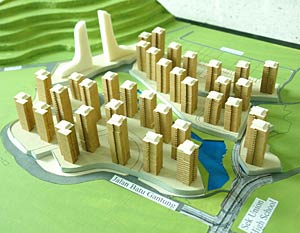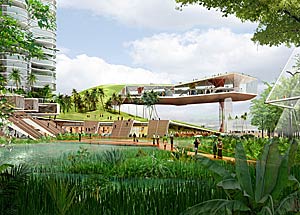As public opposition mounts against the Penang Global City Complex (PGCC), a massive redevelopment scheme in Malaysia, chief minister Dr. Koh Tsu Koon, head of the state of Penang, has requested revisions from the developer, Equine Capital subsidiary Abad Naluri.



The Anti-PGCC campaign, a coalition of groups that opposes the Penang Global City Complex, has created a model that it claims depicts the excessive density of developer Equine Capital’s proposed 36 towers (top). Renderings by the PGCC’s master planner, Seraji Architects & Associates, depict a more open landscape filled with retail shops, residential towers, and gardens (middle). As yet untouched by controversy, the PGCC’s signature project is Asymptote’s twin 60-story towers, located at one end of the site (above).
At issue is a dense urban component of the 256-acre mixed-use project: some 36 towers, each rising 40 stories, at a proposed density of 36 units per acre and 54 units per acre. Currently the site is zoned for only 6 units per acre. PGCC will be located on the former Penang Turf Club site, an open greenfield once popular for horse racing and golf. Ateliers Seraji Architects & Associates, a Paris-based firm, is the master planner for the development, which it describes as a metropolitan-garden city.
According to Nicholas Risteen, a designer with Seraji, the controversial 36 towers were not a part of the original plan. “The developers needed to meet the bottom line,” he says. The $7 billion project is expected to be a catalyst for a multi-billion-dollar government initiative, the Northern Corridor Economic Region, which aims to heighten Penang’s role in the global economy.
A dozen non-governmental organizations have joined forces as the “Anti-PGCC Campaign” to oppose the project. In addition to holding rallies, the groups lead an effort that resulted in more than 2,500 postcards being mailed to chief minister Koh. Many Penangites are apprehensive about the impact that the large-scale development might have on an already troublesome traffic problem. The developer claims the PGCC will be carbon neutral, but an Environmental Impact Assessment has not been completed and members of the Anti-PGCC Campaign express concern over losing one of the last open spaces in Penang to this massive development. The current proposal also falls short of meeting affordable housing requirements.
Chief minister Koh has requested that developer Abad Naluri revise the PGCC plans to meet the zoning and affordable housing allotments, and address public concerns of traffic and pollution. Ahmad Chik, a councilmember of the Penang Heritage Trust, one of the leading organizations in the Anti-PGCC Campaign, says that his group will continue its efforts against the project even in light of the chief minister’s actions. “The general elections will be held in about two months, and Dr. Koh is having to answer for some very bad development decisions. We certainly do not intend to stop here,” he says.
Calls to the developer were not returned. But Equine Capital’s executive chairman, Patrick Lim, recently told The Edge Daily, a Malaysian business publication, that he remains committed to the development: “It is our intention that the project not only complies fully with all statutory requirements, but that it is also beneficial to all stakeholders.”
For the time being, one element of the PGCC that does not appear to be in flux is the project’s centerpiece, designed by the New York City-based firm Asymptote. Renderings released last year reveal two sinuous, 60-story steel-and-glass-clad towers encompassing 11-million-square-feet of luxury residences, hotels, a performing arts center, a convention center, offices, and shops.
“I understand the master plan is going through many changes in response to the questions raised,” says Hani Rashid, a principal of Asymptote. “Nothing on our project has been deemed controversial. Therefore, no changes have been asked of us.”
The Anti-PGCC Campaign had hoped that chief minister Koh would request that the current greenfield be left open as a public space. “Sadly, that is not likely to happen,” Chik says. “There is a wide gulf between our expectations and that of the developer. We expect a tough fight.”

Post a comment to this article
Report Abusive Comment